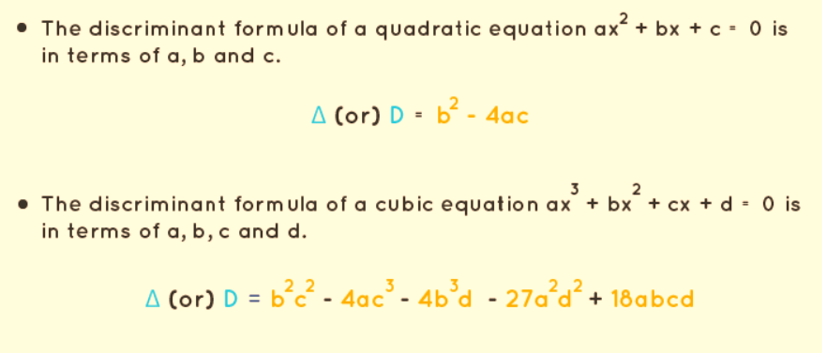
Discriminant formulas are crucial in understanding and analyzing polynomial equations, particularly quadratic equations. The discriminant provides essential information about the nature of the roots of the equation. Here's an overview of the discriminant formulas for a quadratic equation:
Given a quadratic equation in the form of ax² + bx + c = 0, the discriminant (Δ) is calculated using the formula:
Δ = b² - 4ac
Now, let's discuss the implications of the discriminant value (Δ):
- If Δ > 0: The equation has two distinct real roots.
- If Δ = 0: The equation has one real root, also known as a repeated or double root.
- If Δ < 0: The equation has two complex roots (conjugate pairs), which are not real.
Solving quadratic equations using the discriminant can help determine the nature and number of solutions
What Are Discriminant Formulas?
The importance of the Discriminant formulas in assessing the nature of roots in polynomial equations. Let's summarize the discriminant formulas for both quadratic and cubic equations:

For Quadratic Equations:
Given a quadratic equation in the form ax² + bx + c = 0, the discriminant (Δ or D) is calculated as:
Δ = b² - 4ac
For Cubic Equations:
The discriminant formulas of a cubic equation, in the form ax³ + bx² + cx + d = 0, can be more complex and varies depending on the particular cubic equation. It doesn't have a single, universal formula like the quadratic discriminant. Instead, the nature of the roots is determined through an analysis of the coefficients and various conditions. This can involve concepts from advanced algebra and calculus.
The discriminant formulas for quadratic equations is a straightforward and useful tool for quickly assessing the roots, whereas the discriminant for cubic equations often requires more detailed analysis based on the specific equation's coefficients and properties.
Discriminant Formulas of a Quadratic Equation
When the discriminant (Δ) formula of a quadratic equation is negative, it implies that the equation has no real roots, but it does have two distinct complex roots. These complex roots are typically in the form of a ± bi, where "a" and "b" are real numbers, and "i" represents the imaginary unit (i.e., the square root of -1).
For example, if you have the discriminant Δ = -4, the quadratic equation will yield two complex roots:
x₁ = (-b + √Δ) / (2a) = (-b + 2i) / (2a)
x₂ = (-b - √Δ) / (2a) = (-b - 2i) / (2a)
These complex roots are valuable in mathematical and scientific applications, and they represent the solutions to equations that do not have real roots due to the discriminant being negative.
Discriminant Formulas of a Cubic Equation
The discriminant formulas of a cubic equation ax 3 + bx 2 + cx + d = 0 is, Δ (or) D = b 2 c 2 − 4ac 3 − 4b 3 d − 27a 2 d 2 + 18abcd. We know that a cubic equation has a maximum of 3 roots as its degree is 3. Here,
- If D > 0, all the three roots are real and distinct.
- If D = 0, then all the three roots are real where at least two of them are equal to each other.
- If D < 0, then two of its roots are complex numbers and the third root is real.
Also Check – Rational Number Formula
Discriminant Formulas Examples
Example 1 : Find the discriminant of the quadratic equation 5x 2 + 3x + 2 = 0 using the discriminant formulas.
Solution:
The quadratic equation is 5x 2 + 3x + 2 = 0.
Comparing the given equation with ax 2 + bx + c = 0, we get a = 5, b = 3, and c = 2.
Applying the discriminant formula, we get
D = b 2 - 4ac
= 3 2 - 4(5)(2)
= 9 - 40
= -31
Answer: The discriminant is -31. Since it is a negative number and so, it will have two complex roots.
Example 2: Find the discriminant of the quadratic equation 2x 2 + 8x + 8 = 0 using the discriminant formulas.
Solution:
The quadratic equation is 2x 2 + 8x + 8 = 0.
Comparing the given equation with ax 2 + bx + c = 0, we get a = 2, b = 8, and c = 8.
Applying the discriminant formula, we get
D = b 2 - 4ac
= 8 2 - 4(2)(8)
= 64 - 64
= 0
Answer: The discriminant is 0 and So, it will have two complex roots.
Example 3: Determine the nature of the roots of the cubic equation x 3 - 4x 2 + 6x - 4 = 0 using the discriminant formulas.
Solution:
The cubic equation is x 3 - 4x 2 + 6x - 4 = 0.
Comparing the given equation with ax 3 + bx 2 + cx + d = 0, we get a = 1, b = -4, c = 6, and d = -4.
Applying the discriminant formula, we get
D = b 2 c 2 − 4ac 3 − 4b 3 d − 27a 2 d 2 + 18abcd
= (-4) 2 (6) 2 − 4(1)(6) 3 − 4(-4) 3 (-4) − 27(1) 2 (-4) 2 + 18(1)(-4)(6)(-4)
= -16
Answer: As the discriminant is negative so the given cubic equation has two complex roots and one real root.
Also Check – Ratio and Proportion Formula
Discriminant Formula Applications
The discriminant is a mathematical formula that is primarily used in the context of quadratic equations. The discriminant provides valuable information about the nature of the solutions (roots) of a quadratic equation. Its applications include:- Nature of Roots: The discriminant formulas is used to determine the nature of the solutions to a quadratic equation. There are three cases: If the discriminant (denoted as Δ or D) is positive, there are two distinct real solutions. If the discriminant is zero, there is one real solution (a repeated root). If the discriminant is negative, there are no real solutions, but two complex (conjugate) solutions.
- Quadratic Equations: The discriminant formulas is widely used in solving and analyzing quadratic equations, which are equations of the form ax 2 + bx + c = 0. The formula for the discriminant is Δ = b 2 - 4ac, where a, b, and c are the coefficients of the quadratic equation.
- Geometry: In geometry, the discriminant formulas can be used to analyze conic sections. For example, it can help determine whether a conic section is an ellipse, a hyperbola, or a parabola based on the coefficients of the equation representing the conic section.
- Optimization Problems: In optimization problems, where you need to find the maximum or minimum value of a quadratic function, the discriminant can help determine whether such extrema exist by analyzing the sign of the discriminant.
- Engineering: In engineering, the discriminant formulas can be used in various applications, such as analyzing stability in control systems, solving problems related to mechanical vibrations, or determining the nature of solutions in problems involving oscillations.
- Roots of Quadratic Functions: The discriminant formulas can be applied to determine the roots (solutions) of quadratic functions in various fields, including physics, economics, and finance, where quadratic models are often used to describe relationships or make predictions. Computer Graphics: In computer graphics and 3D modeling, quadratic equations are used to represent curves and surfaces.
| Related Links | |
| Fibonacci Sequence Formula | Eulers Formula |
| Exponential Formula | Factorial Formula |
D<span style=
What is the discriminant in the context of quadratic equations?
What does the discriminant tell us about the roots of a quadratic equation?
Is the discriminant formula applicable only to quadratic equations?
Can the discriminant be used to find the roots of any polynomial equation?
What if the discriminant is negative in a quadratic equation?










